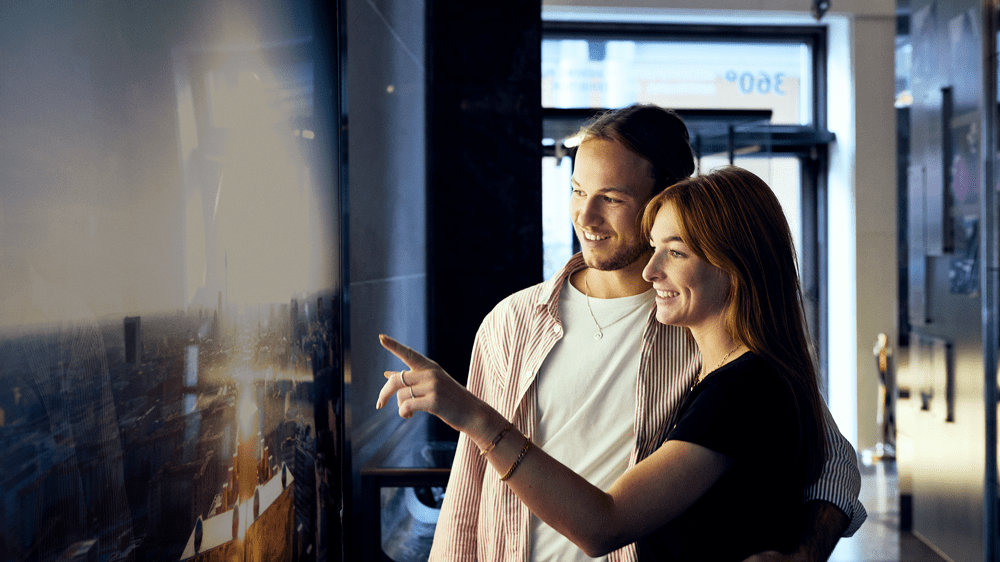
SIGHTS OF BERLIN
Seeing and being seen.
Berlin has a lot to offer so let us show you here what you are going to see perfectly from afar – and what you should definitely check out up close.
Swipen Sie nach links und rechts und überzeugen Sie sich selbst von diesem phantastischen Ausblick.
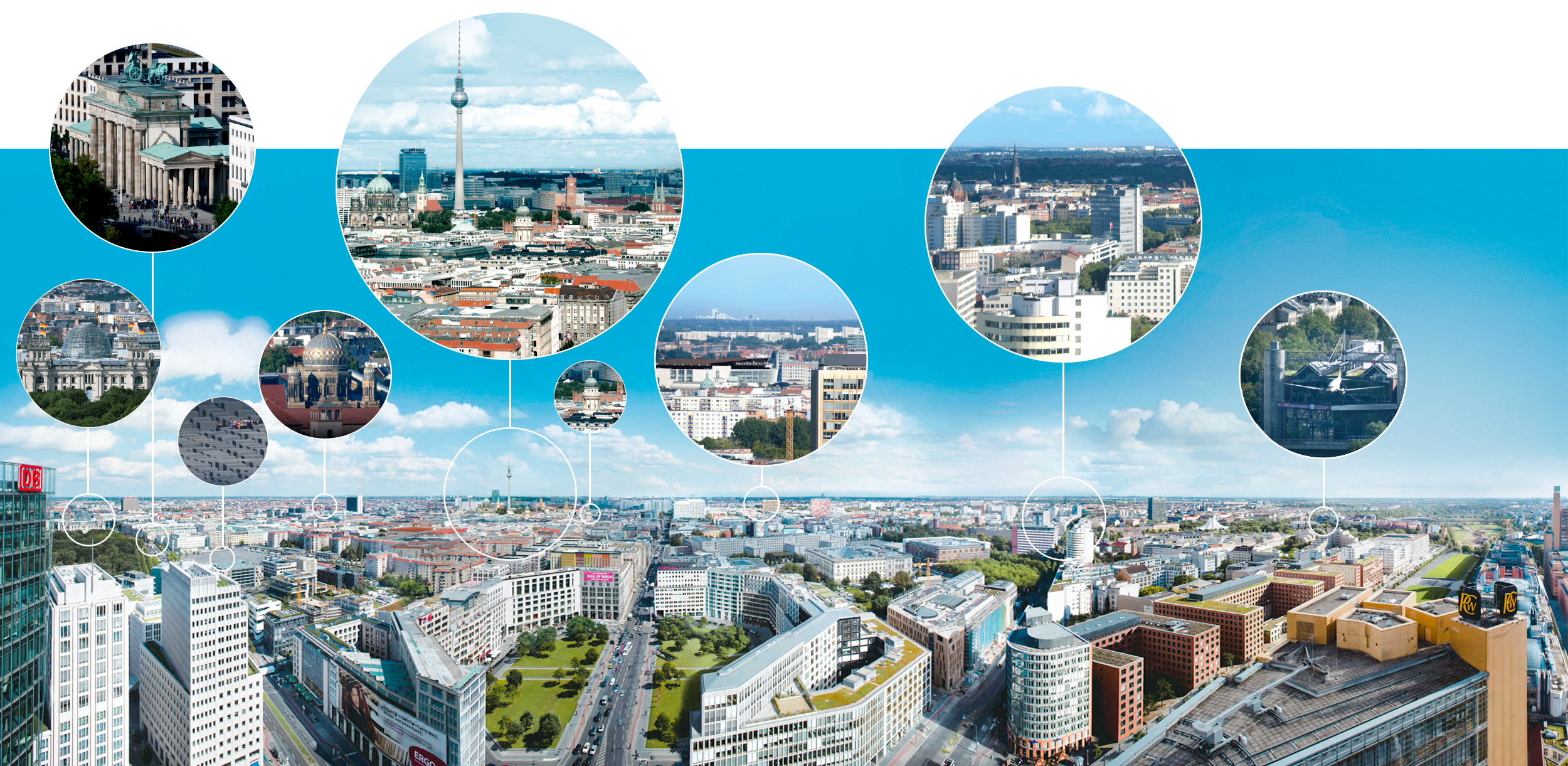
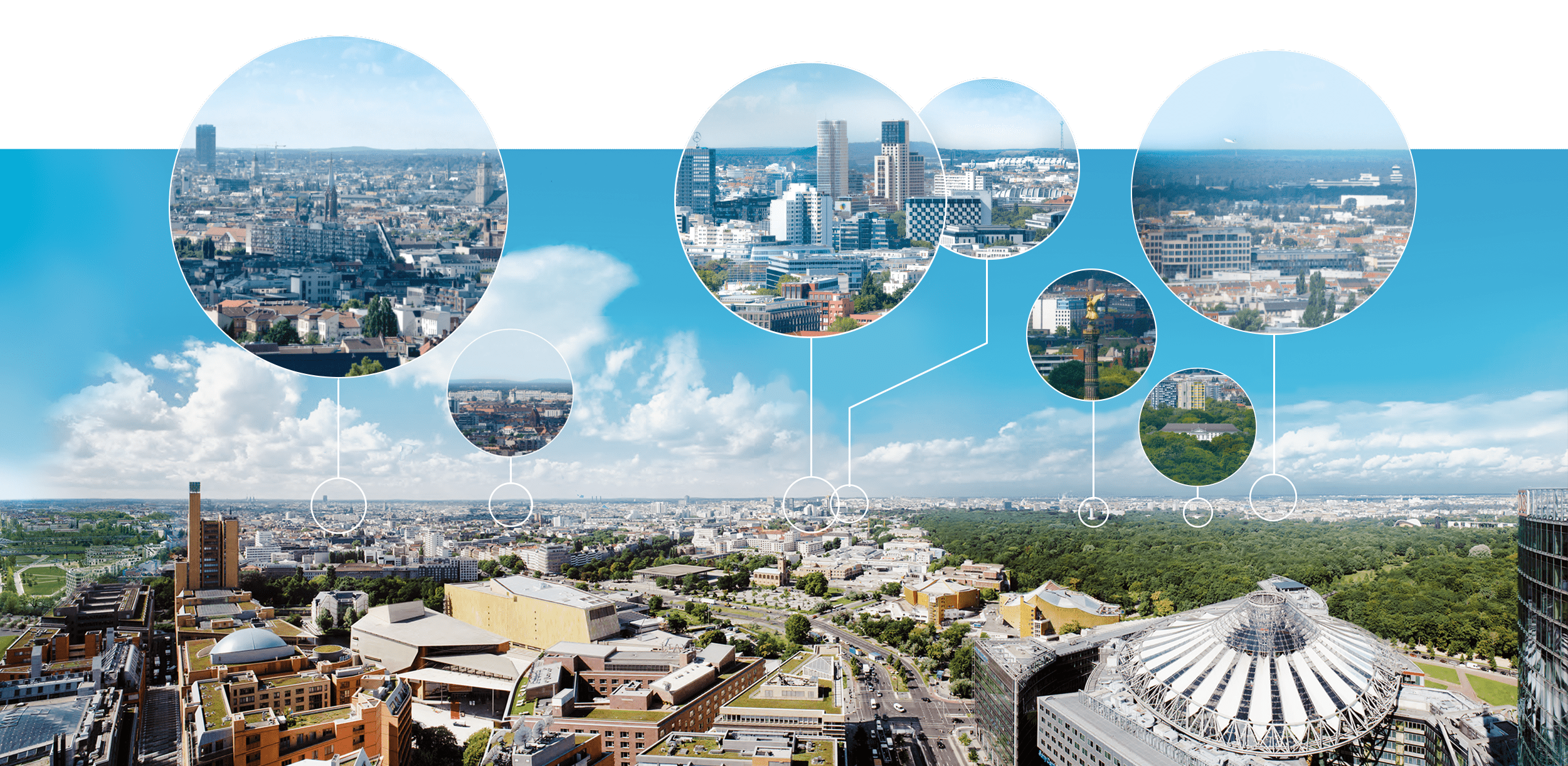
Fahre mit der Maus über
die Punkte und entdecke
die Seheswürdigkeiten in diesem
phantastischen Ausblick.

Fernsehturm am Alexanderplatz
Bahnhof Alexanderplatz
Berliner Dom
Marienkirche
Rotes Rathaus
Staatsoper Unter den Linden
Nikolaikirche
Französischer Dom
Außenhandelsministerium
Holocaust Denkmal
LP12 Mall of Berlin
Leipziger Platz
Reichstag
Charité
Brandenburger Tor
Synagoge
Deutscher Dom
Mercedes Benz Arena
BER Flughafen
Willy Brandt Haus
Heilig-Kreuz-Kirche
Bundesrat
Bundesfinanzministerium
Martin-Gropius-Bau
Checkpoint Charlie
Tempodrom
Museum für Verkehr und Technik
Gleisdreieck
Tilla-Durieux-Park

Apostel-Paulus-Kirche
Rathaus Schöneberg
Steglitzer Kreisel
Kraftwerk Lichterfelde
Debis Tower
Park am Gleisdreieck
Potsdamer-Platz-Arkaden
Ehemaliges 3D-Kuppelkino
Canaris-Haus
Marlene-Dietrich-Platz
Nachrichtensender N24
Staatsbibliothek
Musicaltheater
Landwehrkanal
Hotel Grand Hyatt
Neue Nationalgalerie
Autobahnüberbauung
Matthäikirche
Berliner „Walk of Fame“
Philharmonie
Sony-Center
Großer Tiergarten
DB Bahntower
Kammermusiksaal
Siegessäule
Schloss Bellevue
Bundeskanzleramt
Waldorf Astoria Hotel
Trümmerhalde “Teufelsberg”
Europa-Center
CDU-Bundeszentrale
Hotel Intercontinental
Kaiser-Wilheln-Gedächtnis-Kirche
Funkturm
ICC – Messe Berlin
Bahnhof Zoo
Berlin Tegel
Bundesinnenministerium
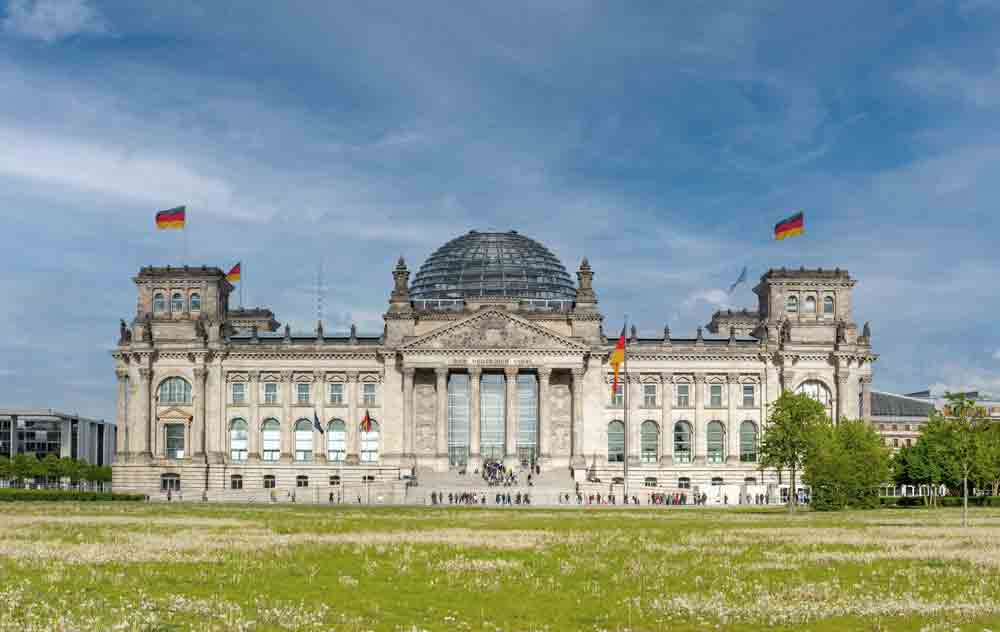
Reichstag
The Reichstag was built between 1884 and 1894 by architect Paul Wallot. Since 1999, the Reichstag has been the seat of the German Bundestag and is now one of the most visited sights in Berlin. A particular highlight for all visitors is the glass dome.
The Reichstag building has been marked by important events in German history. The SPD politician Philipp Scheidemann proclaimed the Republic on 9 November 1918 from the balcony at the west portal. On 27 February 1933, the Reichstag was burned down, completely destroying the plenary chamber and the dome. On 30 April 1945, a red flag of the Soviet Union was hoisted by two Red Army soldiers as a symbol of victory over the Third Reich.
The severely damaged Reichstag was initially not put to any further use after the end of the war. For static reasons, the dome had to be blown up in 1957. In 1957, Paul Baumgarten began the first reconstruction work. A second phase of reconstruction followed from 1994, ending with the first session of the Bundestag on 19 April 1999. The most striking new feature of the Reichstag was the glass dome, which measures 40 metres in diameter and 23.5 metres in height.
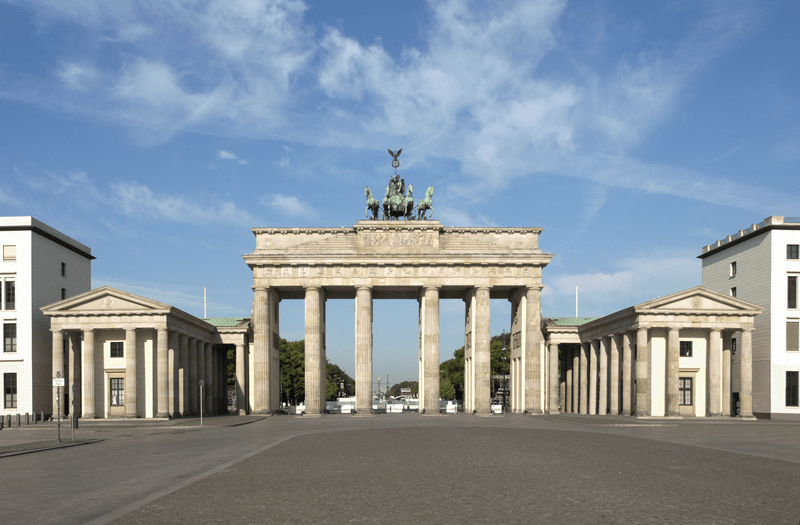
The Brandenburg Gate
The former city gate of Berlin was built by Friedrich Wilhelm II between 1788 and 1791 on today’s Pariser Platz. In 1793, the Quadriga designed by Johann Gottfried Schadow was placed on top of the Brandenburg Gate. After the defeat of Prussia in 1806, Napoleon took the Quadriga to Paris. However, the victory of the Alliance enabled it to be brought back in 1814. During the Second World War, the Brandenburg Gate suffered enormous damage and the Quadriga was so badly affected by the bombing that it had to be replaced by a copy in 1956 as part of the reconstruction of the gate.
With the construction of the Berlin Wall in 1961, the gate was situated in the middle of the restricted area and could neither be passed from the west nor from the east. During the change of regime in the GDR on 22 December 1989, the Brandenburg Gate was reopened to the cheers of more than 100,000 people.
It was restored between 2000 and 2002. After the work was completed, the passageway was closed to motorised traffic due to the enormous damage to the sandstone caused by car exhaust fumes.
According to a survey by the German National Tourist Board, the Brandenburg Gate is one of the most popular sights in Germany and thus a daily attraction for many tourists.
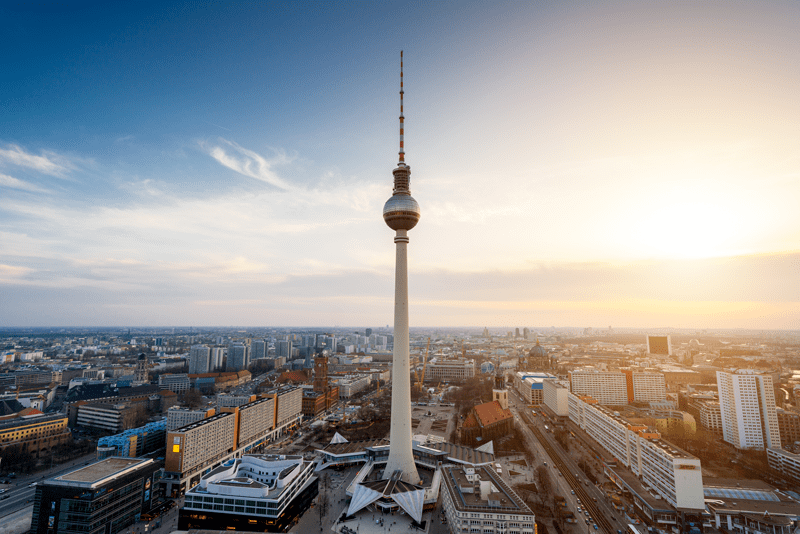
The Berlin TV Tower
At 368 metres, the most prominent landmark in the capital is also the tallest building in Germany. The television tower was completed in 1969 after only 4 years of construction.
For complete and uninterrupted coverage of television reception, a powerful large transmitter with the highest possible location was required. For this purpose, a site in the Müggel mountains was first planned and construction was approved. On 13 December 1955, however, the Minister of Interior, Karl Maron, demanded that the construction work, which was already in full swing, be stopped immediately. It was discovered that the tower, with its planned 130-metre height, was on the edge of Schönefeld Airport’s flight path and could endanger air traffic.
After a new search for a location, a further construction start in Park Friedrichshain was stopped for cost reasons. According to the plan, the television tower in Friedrichshain was to be in full operation by 1964. After more than ten years of inconclusive planning, the SED party leader of the time Walter Ulbricht personally decided to build the TV Tower at Alexanderplatz in 1964.
Every year, approximately 1,000,000 visitors flock to the TV Tower to enjoy the view over Berlin or dine in the tower restaurant on the revolving level.
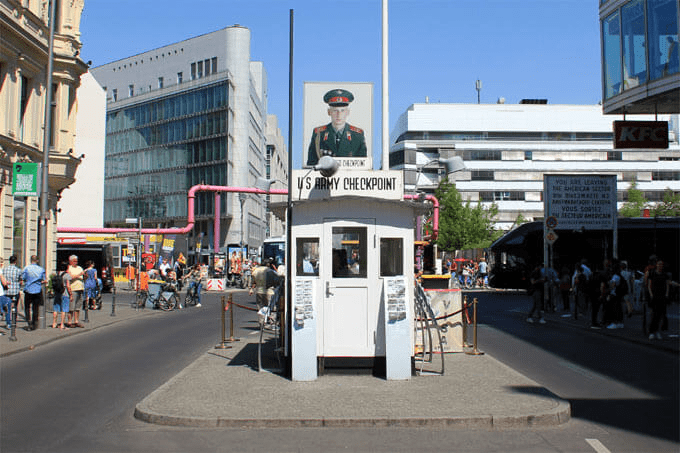
Checkpoint Charlie
Once of enormous military importance, today above all a magnet for tourists: Checkpoint Charlie on Friedrichstraße in the heart of Berlin. It went down in history as the most famous border crossing in today’s capital between the years 1961 and 1990, due to the Berlin Wall. It was set up to record crossings by military personnel and foreign diplomats, among others.
Particularly significant from a historical point of view
Checkpoint Charlie was one of the three checkpoints in Berlin. Like the borders Helmstedt-Marienborn (Checkpoint Alpha) and Dreilinden-Drewitz (Checkpoint Bravo), it was controlled by the Americans.
What exactly happened at Checkpoint Charlie that its significance is still so immensely anchored in people’s minds today? The year 1961 was important for this. On 27 October, Soviet and American tanks faced each other here –carrying loaded weapons. It is known that both sides had orders to attack as soon as it was necessary.
In addition to this drastic experience, numerous escape attempts from the GDR via Checkpoint Charlie were very tragic and for this very reason are still unforgotten today. Among others, the case of Peter Fechter or that of the People’s Police officer Burkhard Niering stand for particular fates of the divided Berlin.
The Victory Column
This historical monument of Berlin, which has existed since 1873, is located at the Großer Stern in the district of Tiergarten. The Berliners call the building, with its total height of 67 metres, the “Goldelse”. At the top, the 8.3-metre-high, gilded bronze figure of Victoria (goddess of victory in Roman mythology) rises into the sky as the focal point of the roundabout. The famous Straße des 17. Juni (Street of the 17th of June) begins here leading directly to the Brandenburg Gate. If you want to see the entire Tiergarten, the “17. Juni” (as the Berliners like to abbreviate it) and the Brandenburg Gate from above, you must only climb 285 steps. At a height of 51 metres, you will be rewarded for your athletic climb with a fantastic panoramic view from the viewing platform.
The centre of many major events in Berlin
Berlin is not called the “party capital” without reason. Berliners like to party whenever the opportunity arises – and often the Siegessäule, or the stretch between the Siegessäule and the Brandenburg Gate, is the focal point of the event. For example, the Siegessäule’s pulpit had been the venue for the closing ceremonies of the “Love Parade” every year, and the famous Fan Mile comes to life here during World and European football championships. The Victory Column and its Victoria have also played an important role in various film productions as a monumental landmark of the city.
The war is history – the Victory Column has history
The “Goldelse” was erected as a national monument for the Wars of Unification. The design by Heinrich Strack was realised between 1864 and 1873. The Victory Column was intended to commemorate the victories over Denmark, Austria, and France at the time. The inauguration in 1873 by Wilhelm I and Otto von Bismarck took place on the former Königsplatz in front of the Reichstag (today: Platz der Republik). It was not until 1938/1939 that the Victory Column was moved to its final location at Großer Stern at an enormous expense. The column is reminiscent of the wartime period through its still existing embrasures. Today, the Victory Column is a listed building. Visitors can reach it via an underground pedestrian tunnel and climb the spiral staircase located inside to the foot of the Victoria.
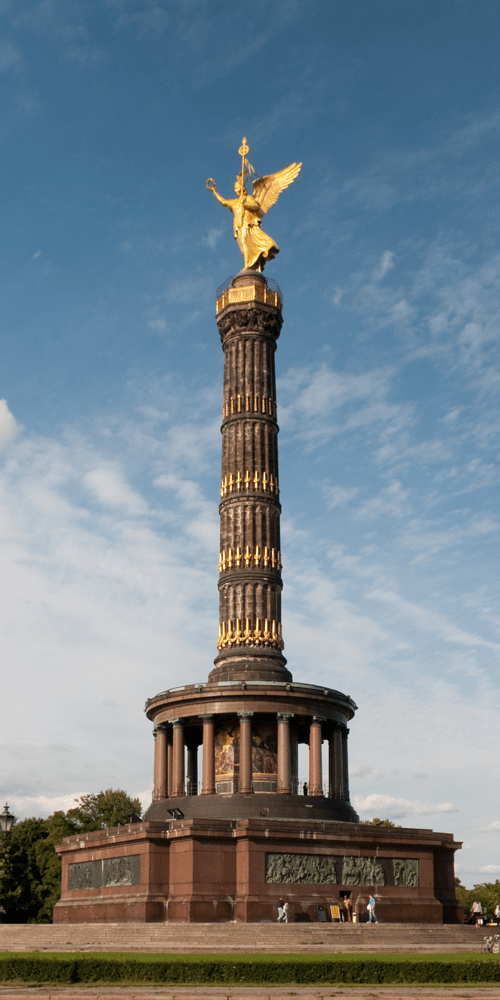

Gendarmenmarkt
Commonly known as the “most beautiful square in Berlin”, the Gendarmenmarkt is located in the heart of the capital in the Mitte district. Once constructed in the 17th century as part of the Friedrichstadt by King Friedrich I in a symmetrical Baroque style, this 3.3-hectare square is now one of Berlin’s most important sites. Over a million visitors come here every year to see the impressive buildings, enjoy food in the restaurants around it or shop in the classy boutiques on Friedrichstraße, which is close to Gendarmenmarkt.
The Trinity of Gendarmenmarkt
Centrally located on the square, which has been decorated with square stone slabs since 1936, is the Konzerthaus, with the Schiller Monument in front of its steps, commemorating the famous poet Friedrich Schiller since 1871. The concert hall is framed to the south by the German Cathedral and to the north by the French Cathedral. Together, the three buildings form a beautiful ensemble of historical architecture:
German Cathedral
Concert Hall
Built from 1701 to 1708 according to the plans of Martin Grünberg and extended by Carl von Gontard from 1780 to 1785 to include the dome tower, the German Cathedral was severely damaged during World War II. After extensive restoration work, it was reopened in 1996. Today you can visit a permanent exhibition about German history on five floors.
French Cathedral
History and festivals in Berlin's most beautiful centre
Originally known as Linden-Markt, later as Friedrichstädtischer Markt and Neuer Markt, until in 1786 it was renamed Gendarmenmarkt in memory of the stables of the cuirassier regiment “Gens d’armes”. After 150 years of being known by the same name, the square was renamed the Academy Square in 1950 on the 250th anniversary of the Academy of Sciences. This historic location has only finally borne its present name since 1991.
Many historical events have taken place here, such as the people’s revolt against increased food prices, the so-called “potato revolution” that heralded the great revolution of 1848/49 – or the GDR government’s farewell with Beethoven’s Ninth Symphony one day before the reunification in 1990.
Today, several events take place here every year that are both worth seeing and hearing: The Classic Open Air, the Festival of Lights, as well as the opening event for the famous film festival in the capital – the Berlinale. A particularly beautiful festivity is the “Weihnachtszauber Gendarmenmarkt” – a traditional Christmas market that should not be missed.
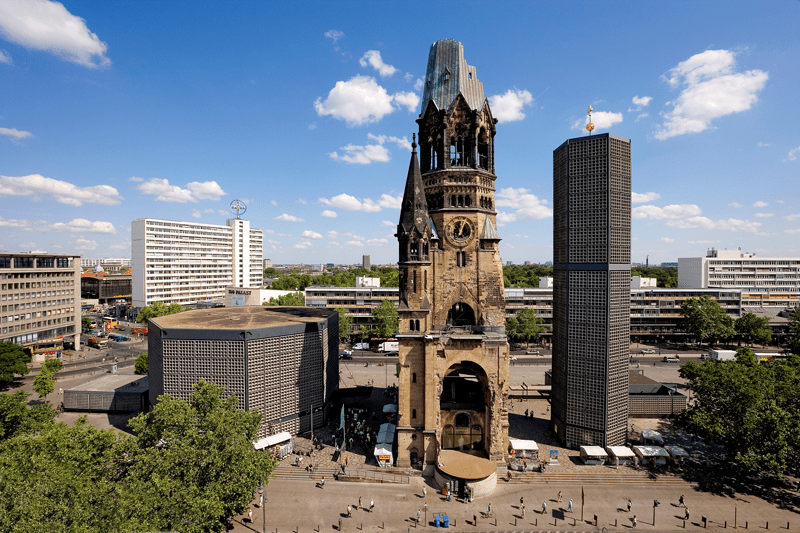
The Kaiser-Wilhelm-Gedächtniskirche
The Kaiser Wilhelm Gedächtniskirche (inaugurated on 1 September 1895) is also known as the “Hollow Tooth” in Berlin slang. The name results from the Allied air raids on Berlin – on the night of 23 November 1943, the building caught fire, the roof frame collapsed, and the top of the tower buckled.
A rock in the waves
In 1957, it was decided to leave the 71-metre-high tower standing as a ruin in the middle of the famous Kurfürstendamm. It is still there today as a memorial to the war. The half-destroyed tower of the Kaiser Wilhelm Gedächtniskirche is surrounded by a four-part building ensemble. This was solemnly inaugurated in 1961. It includes the octagonal new church with its foyer. On the other side of the ruined tower, in which a memorial hall has been set up, are the parish chapel and the new bell tower (hexagonal).
Special highlights inside
In the chapel, where Protestant services are regularly held today, you are greeted by blue light. This is due to the glass walls and windows of the same colour, which originate from France. The artist Gabriel Loire broke the glass into irregular pieces for this purpose. Due to this, incoming light is additionally scattered. The organ has more than 5000 pipes and impresses with a variety of sound colours. The bells in the new church also provide harmonious sounds from the outside.
The Kudamm
Shopping in a class of its own over several kilometres.
The shopping experience begins as early as Tauentzienstrasse at Wittenbergplatz, with the world-famous KaDeWe (Kaufhaus des Westens), leads through the Europa-Center at Breitscheidplatz and the modern Bikini Berlin shopping centre housed in a section of a listed building complex at Zoologischer Garten, and continues on beyond Olivaer Platz. Here, the most famous designer and fashion labels, as well as star hairdressers, have secured their place on the boulevard. The car industry has also recognised the value of this street for setting up its city points. Strolling along Kurfürstendamm is a true experience. Here you can still enjoy the genuine feeling of strolling along a historic shopping street. People also like to show off what they have: from designer handbags to luxury cars.
Night owls on Kurfürstendamm
The Kudamm not only offers everything your shopping heart desires, but also provides all you need for those who like to go out and experience something: Night owls get their money’s worth with various clubs: such as the elegant Puro on the top floor of the Europa-Center, the popular Pearl in Fasanenstraße, just a stone’s throw away from the famous Paris Bar, a sought-after celebrity restaurant, or the classy First Club or Maxxim, where Paris Hilton already danced the night away, and directly below it the Q-Dorf, Berlin’s party village under the city for young and old alike, all three to be found in the Joachimstaler Straße (each a direct side street and a few metres from the Kudamm). Starting from Olivaer Platz, Kurfürstendamm also has its own restaurant, café and bar mile, which is otherwise more typical of the eastern part of the city in Friedrichshain. A popular place here is the Route66 Diner, which pays homage to the 1950s and is even equipped with classic jukeboxes.
Historic causeway – the Kurfürstendamm
As early as 1542, the former Dammweg was built, which found its purpose in enabling electors to travel comfortably from the Berlin City Palace to the Grunewald hunting lodge. It was not until 1886, at the request of Reich Chancellor Otto von Bismarck, that Kurfürstendamm was given its present name. During the Weimar Republic, the boulevard then became the epitome of the “Golden Twenties”. In the 1930s, Kurfürstendamm was turned into a political arena with rampant riots following anti-Semitic attacks. This changed with the Olympic Games in 1936, when it became a showcase street and a flagship for a positive international image. Political demonstrations took place on the Kudamm again and again, for example directly after the fall of the Wall in 1989, as well as the first events of the “Love Parade” until it developed into a mass spectacle and had to be relocated due to the crowds. The changing times meant that local historic cinemas such as the Zoopalast, Royal-Palast and Marmorhaus, as well as some cafés, had to close – whereas the Zoopalast has since reopened. Subsequently, today’s Kurfürstendamm developed into one of the most exclusive shopping streets in Germany.
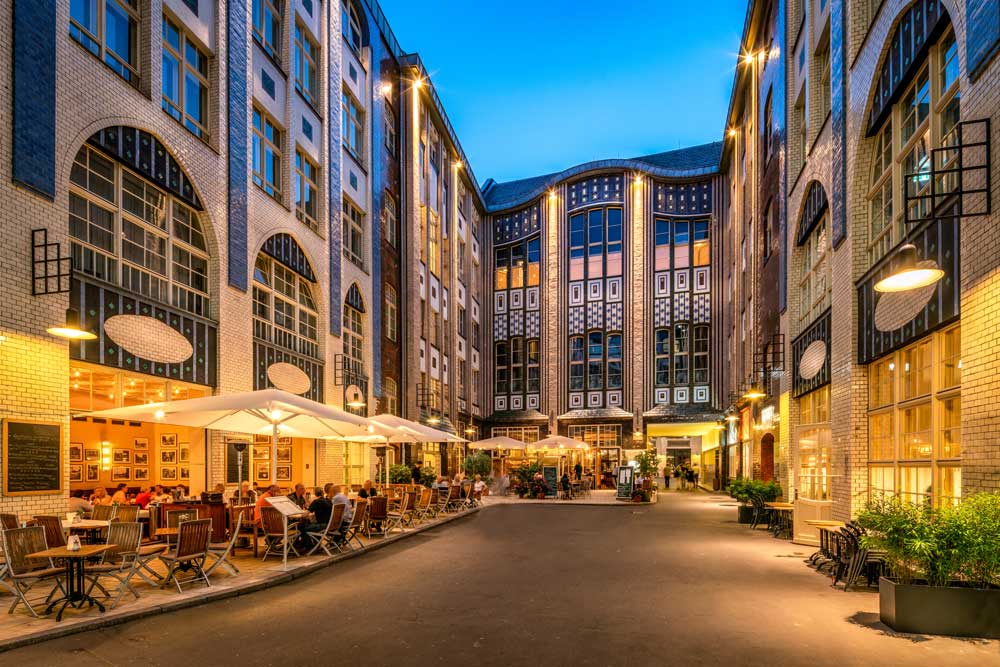
The Hackescher Markt
The area around Hackescher Markt is a trendy district that is particularly popular with the shopping-savvy and creative people, as well as the party crowd of the capital. This square, located between Rosenthaler Platz and Friedrichstraße in the Mitte district, is a traffic junction, shopping mile and starting point for Berlin’s nightlife all at the same time. The Oranienburger Straße, which is extremely well-known in Berlin and is often compared to St. Pauli’s sinful mile in Hamburg, begins here. However, this street offers much more: numerous cafés, bars and restaurants and everything in the immediate vicinity of the Spree. Thus, it is possible to sit comfortably by the water and enjoy one or more cocktails until late into the night.
Changing times – unfolding from Hackescher Markt
Hard to imagine, but true – the place where Hackescher Markt is located today was originally a marshy area. It was not until around 1750 that the square was laid out by the Berlin city commander Count Hans Christoph Friedrich von Hacke on the orders of Friedrich II. Since 1840 it has officially borne the name Hackescher Markt. In the 19th and 20th centuries, the development of public transport turned the place into a hub.
Probably the biggest change occurred after the reunification of Germany: Old buildings were renovated and gaps between buildings have been closed. This attracted many designers, workshops and restaurateurs to the area after the fall of the Wall. This is how Hackescher Markt gradually transformed into the trendy district it is today. The famous am to pm directly at the Hackescher Markt train station is open 24 hours a day and has become a hotspot for many visitors from all over the world
Hackesche Höfe – simply worth seeing
Germany’s largest enclosed courtyard complex is located directly at Hackescher Markt: the Hackesche Höfe. Since the fall of communism in 1990, this courtyard complex has been extensively renovated and is now a listed building. Various restaurateurs, artists, jewellery and fashion designers take advantage of the opportunity to settle in this area. It is sometimes considered the most valuable location in the city.
